Can collaborations between artists and ecologists inspire new ways forward?
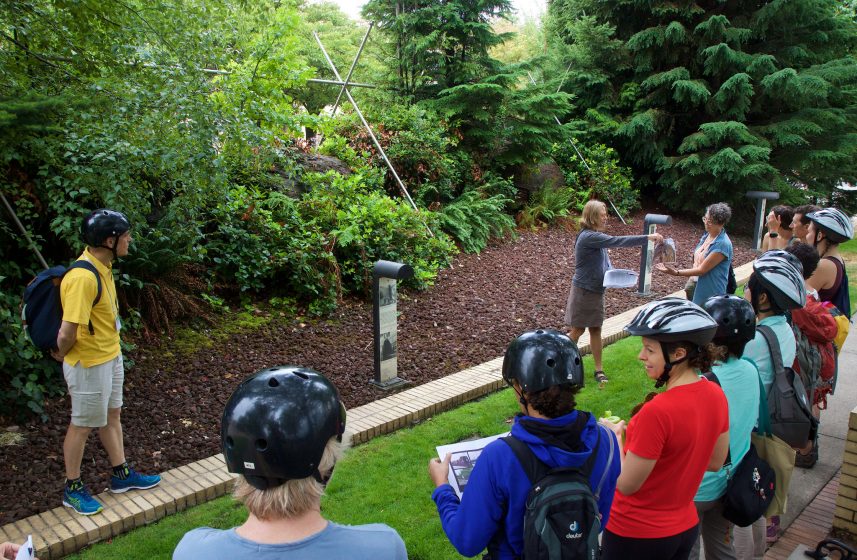
To explore this idea, I collaborated with artist Linda Wysong. Together we designed a bike ride field trip as part of the Ecological Society of America’s annual conference in August this year. The bike ride starts at the conference center with Linda and me as guides for the visiting ecologists. Artist Peg Butler helps us interpret our first stop: “Host Analog” by Buster Simpson. Simpson created a “process piece” by taking an old growth log from an ancient forest, brought it to the city and let it be. Sprinklers were installed, but weeding was forbidden. Twenty years ago it was a bare spliced log, and now it is a mini wild forest surrounded by a brick plaza next to a metro stop. Buster, in effect, brought the wild into the city, forcing us to contend with natural processes, changing aesthetics, and re-connecting ancient forests to the city.
We weave down a bike path along the Willamette River, with views of the central city, stopping near the Hawthorne bridge in one of the heaviest used sections of the river. It is also an ecological restoration site. The program I work for tried to establish a native forest in soils that were a composite of rock and concrete fill, with more rock placed on top. What does ecological restoration mean in the middle of the city, and who is the restoration for? People reclaimed this spot with the help of trail and boat dock improvements, but the mix of native plants continues to struggle, as do the salmon that migrate in the river below.

Our next stop is at Oaks Bottom, a natural area that has been transformed by both Linda’s public art pieces and the forest restoration work that I have been a part of. In this riparian forest, we explore where art and ecology overlap by opening our senses and noticing our surroundings. We walk silently in the forest for ten minutes. Then Linda describes her sculpture “Shifting Assets”, formed from a glacial erratic stone mined from the river. The basalt stone was sliced and layered with translucent acrylic that changes with the sun and the season. Linda’s sculpture creates a meeting spot, a discovery and a conversation with the river. The ecological work transformed the bramble thickets to a young riparian forest, adding structure and shade with the intention of improving wildlife habitat and water quality. Although different in expression, both of our labors speak to place making for humans and non-humans alike.
Our bike ride continues to a local gallery, Indivisible, run by Christine Toth, where we eat tacos and discuss art and ecology. Linda curated the art show featuring Peg Butler, Bruce Conkle, Egg Dahl, Ardis DeFreece, Adam Kuby, Vanessa Renwick, Buster Simpson, and herself. We are joined by Vanessa, Ardis, Peg, Bruce, and Emily Bosanquet, founder of the Art + Science Initiative at Pacific Northwest College of Art (PNCA) to discuss where our disciplines overlap, and how we can better work together. One ecologist suggests there wasn’t always a division between art and science. Leonardo Da Vinci sketched and painted, continually updating and improving his observation skills, which improved his art and scientific ventures. Another ecologist found it to be true as well: by sketching a plant, he learned more about its structures and its ecological functions. Artists are often masters at observation and take the time to interpret what they see and feel. Scientists often do the same, but use data collection and analysis to aid in their interpretations. Also mentioned was that artists tend to be poor note takers and scientists poor communicators. By working together, artists and ecologists can remediate their weaknesses. Collaboration could also lead to breakthroughs in sustainability science, new methods to translate and document ecology, and provide a platform for a deeper connection between people and the land. Thinking about all the possibilities, we all agreed that these conversations need to continue and advance into more tangible partnerships.

Art and ecological restoration
I am fortunate to manage a natural area that is dotted with carved stones by Fernanda D’Agostino. While Linda’s work highlights the site’s industrial and environmental history, Fernanda highlights the unseen: the plankton, diatoms, and invertebrates. D’Agostino’s most recent work, Generativity, is an immersive experience, forcing viewers to be inside natural systems, or to acknowledge that they are already inside natural systems. Her art serves as a conduit for interpretation, discovery, and connection to place.
Portland Ecologists Unite!, a local igniter of ecological conversations of which I am founder and a steering committee member, curated six artists to be a part of a panel discussion titled “How art is necessary in ecological restoration”. This discussion took place inside an ecological restoration conference on the opening night and served as inspiration for the rest of the proceedings. One artist on the panel, Ka’ila Farrell-Smith, is a contemporary Klamath/Modoc indigenous artist. She utilizes painting and sculptural art forms to explore the space between indigenous and western worlds. A major goal of Ka’ila’s work is to acknowledge indigenous land, and to perpetuate narratives that embrace the indigenous paradigm of inter-generational community. Indigenous voices are crucial in the dialogue of how to create sustainable and just landscapes. Ka’ila gave attendees a gift of shedding light on the current and historical injustices that have occurred on the land, and inspired many people through her words and her art.

Collaborations between artists and ecologists
Ka’ila is also the co-director of Signal Fire Arts, an NGO that brings artists into wild places, educating them about public lands and creating space for collaboration and art making. Signal Fire knows the value of artists in society, and that they are essential in the struggle to protect our planet. They also have created the Tinderbox residency which embeds artists in environmental non-profits. Those artists then create work that informs, promotes and translates the non-profits work into something tangible, thought-provoking, and creative, such as Holcombe Waller’s collaboration with Columbia Riverkeeper. PNCA has created an Art and Ecology Minor for students “who want to reimagine what art and design can do in the world” and creates student residencies in public agencies. These organizations are merging arts and ecology and creating transdisciplinary dialogue and advocates for a greener tomorrow.
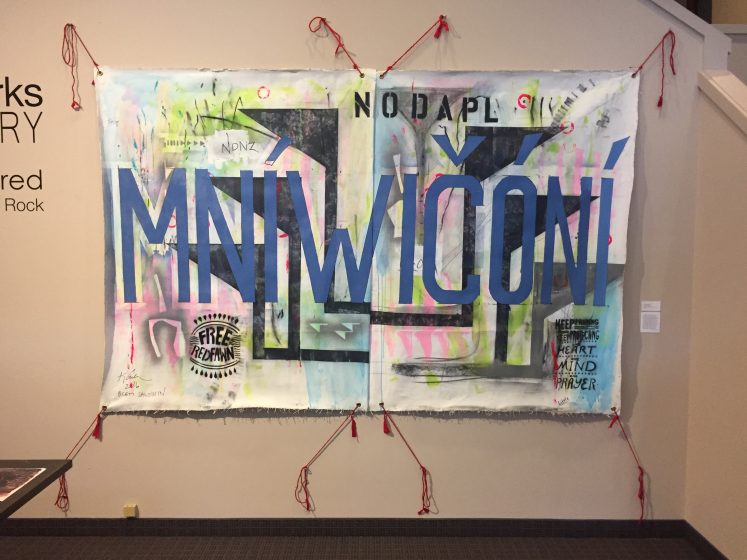
These examples are excellent models, but I would like them to become more commonplace, with artist-in-residence programs in NGOs, scientific conferences, and within governmental agencies. This would benefit the larger society by igniting new conversations and triggering the formation of new partnerships that could prepare organizations to better adapt to current and future situations. It’s a tough sell, using public money to hire artists, but it’s worth it! We are already using public dollars for public art works, why not have artists work from inside public agencies? Merle Laderman Ukeles spent nearly 40 years as an artist-in-residence at the New York Department of Sanitation. She researched the complex garbage disposal system and created art and performances. One performance took over a year, in which she shook hands with each of the 8,500 sanitation workers. In-effect she broke down barriers between districts and disciplines in the department, and was a conduit in revealing the maintenance work that thousands of workers do each day to keep New York City clean.
What can ecologists gain from artists?
Many ecologists have been trained to look for linear associations; e.g., this animal causes the reduction in this plant. But ecology, at its best, is a systems science. Ecologists seek to know how all parts are interrelated, how those connections function with each other, and how the interactions change with different influences. In our current world of accelerating change ecologists need creativity (and artists!) to help discover important components of the socio-ecological system. Ecologists are brain heavy and eye heavy, learning what’s relevant through observation, notation, and reading. We rarely use our ears, our nose, our hands, or our whole body to assess the ecosystem and our effects on it. Creek College is an experimental school that works to empower all senses to creatively connect and explore the natural world. I attended a few Creek College classes, and they were all compelling, in that they changed my perspective on how to see and sense the landscape. Classes included a soundscape exploration with Lisa Schonberg, an indigenous plant medicine class with Clay River, and a movement class led by Hannah Krafcik and Emily Jones. Creek College has created workshops that are exploring exactly what I’m trying to articulate: that transdisciplinary dialogue and information sharing can create a more connected and inspired human community. This inevitably leads to new ideas, new energy, and potential to transform the future.
Adam Kuby is an artist and landscape architect who seeks to add niches and ecological value to the built environment. He has proposed a Peregrine falcon nest cliff built into the face of a downtown building and to convert a rock jetty into a series of tide pools. These are outcomes that most ecologists would embrace, but only an artist could envision and elaborate on the idea. In collaboration, artists and ecologists, along with decision makers can produce inspiring and eco-friendly infrastructure.
There are calls to change the way sustainability science and ecology is practiced in the city. Grove et al. (2016) argue to form project teams in which scientists and decision makers work collaboratively. This approach is great but will have better outcomes if artists are equal players within these project teams. This happens when all parties are paid equally, where there is a horizontal power structure, and where there is space for the artist, scientist, and decision maker to explore ideas without the need for preconceived outcomes. It’s in the exploration that creative ideas can be formed and elaborated. Ideas coupled with science and policy can identify leverage points for change.
Now more than ever we need to embrace artists. Artists have helped change my perspective on how I practice ecology. What I once thought I knew through my studies as an ecologist, I now actually experience. I now notice layers of the soundscape, see multiple values in different plants, and acknowledge layered cultural meanings of wild spaces. Artists bring into focus the complexity of our current situation, and in the complexity, there is beauty and potential in uncovering new pathways forward.
Toby Query
Portland
Citation:
Grove, J. M., D. L. Childers, M. Galvin, S. Hines, T. Muñoz-Erickson, and E. S. Svendsen. 2016. Linking science and decision making to promote an ecology for the city: practices and opportunities. Ecosystem Health and Sustainability 2(9):e01239. 10.1002/ehs2.1239








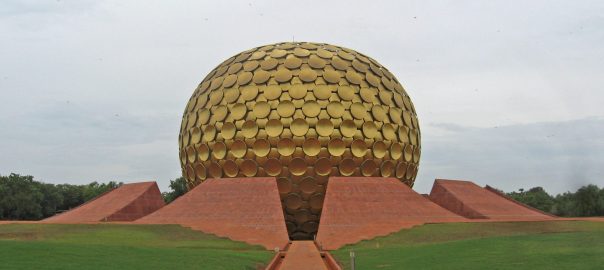
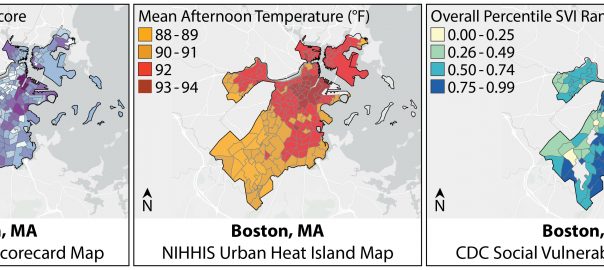

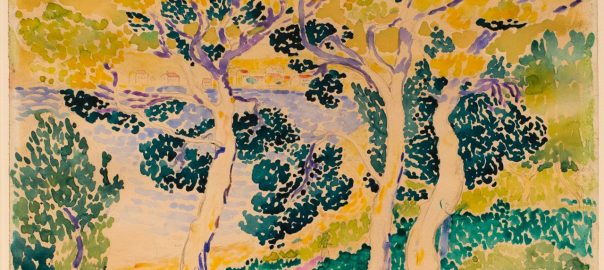
Refreshing and really interesting! Thank you!
To achieve a paradigm shift it is also good to look at arts in the round because the arts market includes trophyism and unethical practices too, which widen inequalities.
A friend of mine – art historian – is now looking at Pliny’s Natural History to re-examine his observations on how we can maintain a balance and best appreciate the earth’s materials in relation to art.
I agree on the point about play and mainstreaming this work as part of research and innovation practice and would firmly support an international residency programme which seeks to do this from 2018 onwards – residencies both for scientists and artists as pollinators! I’m currently researching natural and social capital after working as a public arts producer.
Thanks Toby for a stimulating piece; I too believe that art and artists have an invaluable place in helping us find creative ways to deal with our cities and how Nature permeates them. I feel that many people in the cities have separated themselves from their own natures and that art forms can help to shake them from their lethargy and mental dominance. Much of Nature seems to be play; a play of exploration and naturalness which we all have as children and which takes the back seat when we become some type of professional, selling and competing in our modern world.
To not know or to understand is the beginning of opening to learning and artists have always enticed people into themselves; into their realm of feelings….where anything could happen; the source of ecological health. Lets do it !! Thanks again, Pete